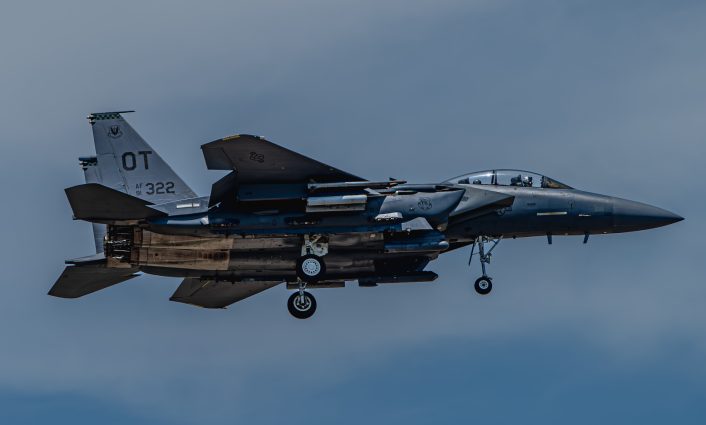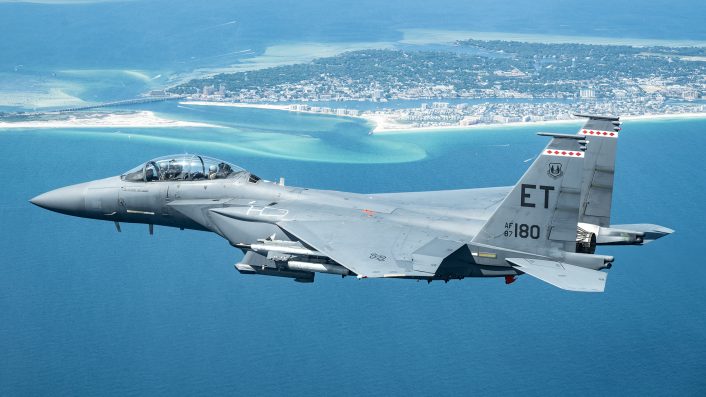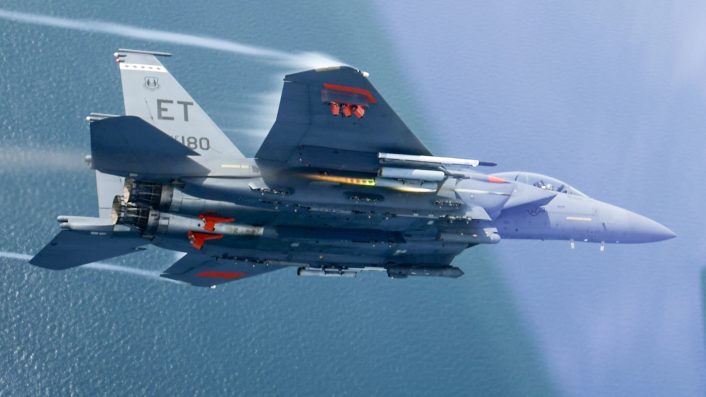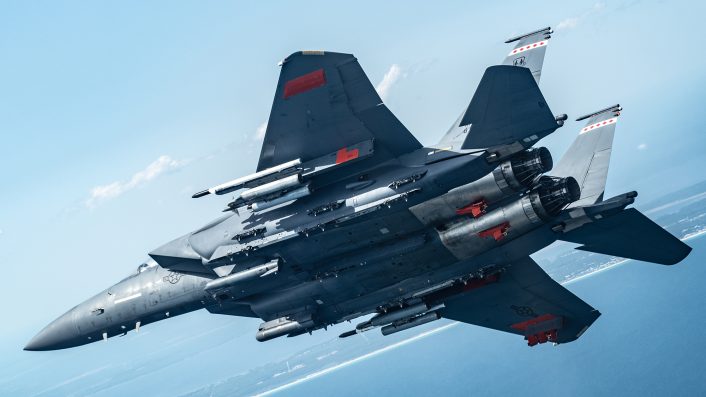The AGR-20 APKWS II was extensively used in combat by Strike Eagles in the Middle East, but these are the first photos to actually show an F-15E firing the laser-guided rockets during tests conducted in May 2025.
U.S. Air Force F-16s deployed to the CENTCOM (Central Command) AOR (Area of Responsibility) have been employing the APKWS (Advanced Precision Kill Weapon System) II in the air-to-air role against Houthi projectiles over the Red Sea since 2024. The laser-guided APKWS II was a solution to the cost disadvantage entailed by using the larger AIM-9 Sidewinder and AIM-120 AMRAAM, costing millions of dollars, against simple one-way attack drones, worth no more than $15,000.
Integration of the APKWS II onto the F-15E began in May 2025, when images surfaced online showing Strike Eagles from Eglin Air Force Base, Florida, flying in a variety of configurations with LAU-131 rocket launchers.

As explained at the time, with six LAU-131 launchers the F-15E can carry 42 laser-guided rockets in addition to its standard loadout of eight air-to-air missiles, a payload that gives the jet up to 50 opportunities to engage aerial targets even before considering the gun, significantly increasing its firepower and flexibility in combat.
The F-15E had been involved in defending Israel against Iran’s drone attacks in April 2024, when the limited number of available air-to-air missiles proved to be a key constraint in countering the waves of hostile drones. An F-15E loaded with large numbers of air-to-air rockets would have enabled longer and more effective counter-drone sorties and this is the reason why the integration was not unexpected.
The work was successfully completed, and the anti-drone configuration was employed extensively in combat by the F-15E Strike Eagles of the 366th Fighter Wing, as shown by the bomb markings carried by the jets returning to their home bases from deployment in the Middle East in July.

Only recently, however, did the Air Force release additional details about the integration effort, including images showing the F-15E during live-fire events carried out by the 96th Test Wing and 53rd Wing at Eglin AFB.
The road to fielding the AGR-20F
The integration and demonstration campaign, which included live-fire events against land and maritime targets, was part of an expedited push to give the warfighter an immediate new tool for the counter-UAS fight, the U.S. Air Force said.
Just days after the final test sorties at Eglin, Strike Eagles were already flying operational missions with the AGR-20F.
“This was our top priority,” Brig. Gen. Mark Massaro, 96th TW commander, said. “The success came from integrated teamwork, out-of-the-box thinking, and the ability to deliver the capability in record time.”

The effort began with a nine-month timeline but quickly ran into a materiel roadblock: no existing way to mount the AGR-20F on an F-15. AFSEO engineers, with the 53rd Test and Evaluation Group, eventually turned to legacy hardware, specifically 1970s-era TER-9A racks and LAU-131 launchers that had been slated for storage in Arizona. Engineers and maintainers modified and mounted the racks, then created a new interface to enable the Strike Eagle’s avionics to communicate with the rockets.
To meet urgent operational demand, airworthiness assessments and demonstration flights ran in parallel. Massaro made the AGR-20F the base’s number one priority, clearing the schedule for rapid testing. Within three days of the order, F-15Es flown by the 40th Flight Test Squadron and 85th and 422nd TES launched the weapon.

The integrated developmental and operational test effort was managed by the F-15 Operational Flight Program Combined Test Force, which synchronized wings, major commands, and program offices to keep the process moving. Support units across the base accelerated logistics, range access, fueling, and mission planning to sustain the surge.
Within nine days, the team completed a process that normally takes more than a year. Airmen then deployed with the equipment to the AOR, training crews on employment and sustainment of the new weapon.
Lt. Col. Jeffrey Entine, OFP CTF commander, summarized the effort: “Our ability to choreograph multiple high-risk test events and deliver a complete product to the warfighter in nine days instead of 18 months shows what Team Eglin can do when tasked.”

Dealing with the APKWS here’s what we wrote in a previous story here at The Aviationist:
[…]
Originally designed as a low-cost, laser-guided precision munition for air-to-ground targets, APKWS II was first tested for air-to-air use in 2019. It offers an affordable option for engaging slow-moving aerial threats such as drones and cruise missiles. During recent operations, F-16s have typically worked in pairs: one aircraft designated the target using the Sniper Advanced Targeting Pod, while the other executed the attack run with the rockets.
Compared to traditional air-to-air missile loadouts, the APKWS configuration allowed the F-16 to increase its engagement capacity significantly. While a standard load of AIM-9X and AIM-120 missiles offers six shots, carrying one or two rocket pods with APKWS enabled the Viper to triple that number. This was achieved at a fraction of the cost as each APKWS rocket is estimated at around 30,000 USD, while an AIM-9X costs approximately 450,000 USD and an AIM-120 exceeds 1 million USD per unit. The tradeoff, however, is that APKWS rockets are only effective against predictable targets with limited maneuverability.
The loadout recently tested on the F-15E takes the concept even further. With six LAU-131 pods installed, the Strike Eagle can carry up to 42 APKWS rockets in addition to its standard complement of eight air-to-air missiles. This gives the aircraft up to 50 engagement opportunities before even accounting for the internal gun. The layout also provides greater operational flexibility: the Weapons Systems Officer in the back seat can laser-designate targets using the Sniper ATP while the pilot concentrates on the engagement, eliminating the need for paired operations like those conducted with the F-16.
The integration of APKWS II on the Strike Eagle appears to be a logical evolution. During the April 2024 Iranian drone attack against Israel, F-15Es were among the aircraft tasked with intercepting the wave of incoming drones. One of the limiting factors during that operation was the limited number of air-to-air missiles available to each jet. An F-15E outfitted with a high-capacity rocket loadout would significantly extend the duration and effectiveness of counter-UAS sorties.
APKWS II has already been fielded across several U.S. platforms, including the USMC’s AV-8B Harrier and F/A-18C/D Hornets, AH-1Z Vipers and UH-1Y Venoms, the USAF’s A-10Cs and F-16s, the U.S. Navy’s MH-60R/S helicopters, and the U.S. Army’s AH-64D/E Apaches.
The APKWS II is based on the Hydra 70 unguided rocket and incorporates a laser guidance kit between the warhead and the rocket motor. This low-cost modification transforms a simple unguided munition into a precision weapon. The system uses four pop-out wings with laser-seeker optics, known as the Distributed Aperture Semi-Active Laser Seeker (DASALS), which provide wide field-of-view tracking for both stationary and moving targets.
To further enhance its counter-UAS capabilities, the APKWS underwent an upgrade under the Fixed Wing, Air Launched, Counter-Unmanned Aircraft Systems Ordnance (FALCO) program. The AGR-20 FALCO version includes updated software that improves its performance in air-to-air roles. This variant is already in use within the CENTCOM area of responsibility and has demonstrated a high probability of kill in operational scenarios.
In addition, BAE Systems has revealed a new infrared seeker for the APKWS II, complementing the laser guidance and making the rocket a dual-mode weapon. This enhancement builds upon the FALCO upgrade and is expected to further improve the Air Force’s ability to counter a wide range of aerial threats.









